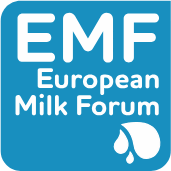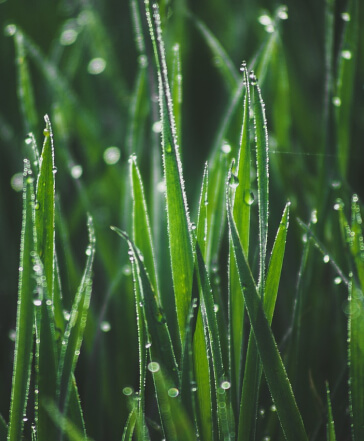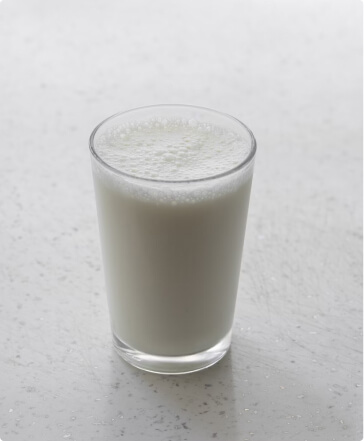Carbon farming promotes a way of farming to fix carbon in agricultural soils. More organic carbon in the soil leads to better soil quality and better infiltration of rainwater, which also remains availa-ble for crops for longer. For example, carbon farming contributes to reducing climate change and makes farmers more resilient to the consequences of climate change, such as heavy rainfall and longer periods of drought.
But what techniques can dairy farmers use to build up more carbon in the soil? With carbon farming, it really comes down to keeping the soil covered as much as possible, minimally tilling it and applying a sufficiently diverse crop rotation. Techniques that are easy to apply to introduce more carbon include sowing green cover crops so that no more soil is exposed, and more biomass is built up underground. You can also incorporate harvest residues – such as straw, which contains quite a bit of organic carbon – or replace monoculture maize with a rotation with grains or lucerne. You can also replace arable land with permanent grassland or add carbon by applying compost or farmyard manure.
Permanent grassland, farmyard manure and the planting of hedges are three popular measures in the story of carbon farming. A more far-reaching practice is agroforestry or agroforestry, where dairy farmers plant trees on their agri-cultural plots or in the meadows where the cows graze.
Hoeve Heirbaut in Temse compensates Milcobel’s CO2 emissions locally
Ginny de Meulemeester: “Every farmer can do carbon farming. We ourselves are strongly committed to permanent grassland. Our cows’ ration consists of a mixture of grasses, clovers and herbs from eight different plant families that we grow here on the farm.” Kris Heirbaut: “In recent years, more and more farmers are looking for new revenue models. Carbon farming can certainly play a role in this. Securing more carbon in the soil ensures higher soil fertility. In the long term this means a big advantage for the farmer, but in the short term you can also make gains in the fight against global warming. If you also receive a payment on top of that, it provides exactly what farmers are looking for: extra financial resources.”
Kris Heirbaut and Ginny de Meulemeester dairy farm:
- 70 dairy cows
- Annual production of 400,000 liters of milk
- Carbon farming via the Claire platform
- Compensates part of the CO2 emissions of dairy cooperative Milcobel
Another step closer to 100% circular dairy farming
Interview with Ruben Puype, Corporate Sustainability Officer at Milcobel
Dairy cooperative Milcobel was the first Belgian company to join Claire at the end of 2021. “We are linked to one of our member dairy farmers who, among other things, does agroforestry. No better example of sustainability together! We strongly believe in this concept, which supports carbon farming practices, among other things,” says Ruben Puype, Corporate Sustainability Officer at Milcobel, the dairy cooperative of around 2,000 Belgian dairy farmers.
By storing carbon in the soil, dairy farmers can be part of the solution to the climate problem. Ruben Puype: “Of course we cannot expect that carbon farming will save the climate, but it is certainly a step forward towards more circular dairy farming, with justified financial compensation for the farmer.”
Does Milcobel have other climate-neutral dairy products in the pipeline? “At the moment there is only our CO2- neutral Bruges Cheese, although there are plans to expand. The reactions are already very positive. As the largest Belgian player in the field of cheese, we wanted to be the first in the sector to create a range. That was our main intention: to make consumers aware in a non-coercive way that their purchasing behavior can be very decisive in several areas. That is why there must be an offer, so that people can make a choice. In any case, the dairy sector has always been a leader in sustainability within agriculture. And we will certainly con – tinue to focus on this. The challenges are great, and we are not there yet, but our dairy farmers are consciously working on the future.”
How do you want to support local farmers even more in their climate-neutral ambitions? “We believe above all in a pragmatic and feasible approach. Not obligatory but encouraged. We do this by rewarding our members with a sustainability premium for the sustainability efforts they make. We also invest in scientific research. For example, Milcobel – together with other partners – supports projects and studies into climate-related measures that dairy farmers can take. Think of Klimrek, which supports farmers in their ecologi-cal progress through a climate scan and guidance process. And GrasKlim, which conducts research into more climate-resistant types of grass that can better withstand prolonged periods of drought and rain. Or Happy CliMi, which looks at feed strategies and by-products to reduce methane emissions from dairy cattle. Also, by supporting such research, we as a cooperative try to do business in a responsible manner and guarantee the future of our dairy farming and dairy sector.”




